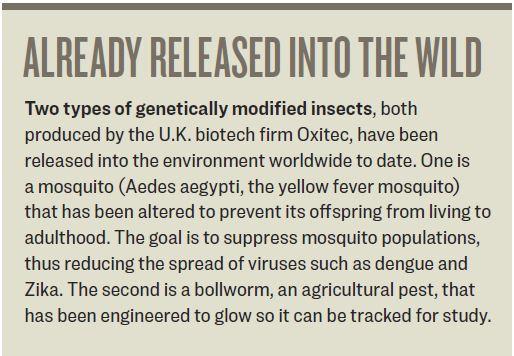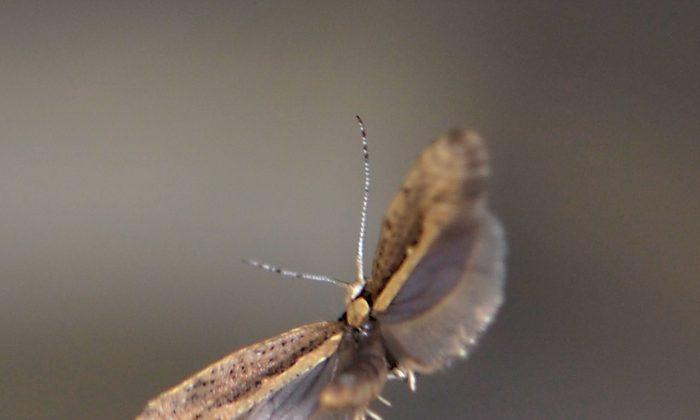A precedent-setting release of genetically engineered insects could soon take place in Geneva, New York. On July 6, the U.S. Department of Agriculture (USDA) approved the release of a moth designed to self-destruct.
Its mission is to mate with wild diamondback moths, which are an agricultural pest, and produce offspring that will die before reaching maturity. Scientists at Cornell University’s Geneva campus, working with biotech company Oxitec, have inserted a genetic “kill switch” in the moths that is triggered while they are still larvae. The moths contain genetic elements from viruses, bacteria, and coral, among other organisms, according to the nonprofit GeneWatch.
Many concerned organizations and individuals are now putting pressure on the New York Department of Environmental Conservation (DEC) to halt the release. DEC must approve it before it can go ahead.
While genetically modified (GM) plants are now ubiquitous in the United States, the release of GM insects into the environment is almost entirely new.
Only one GM insect has ever been released in the United States: a pink bollworm designed to glow for tracking and study purposes. Its brief and controversial release happened in Yuma County, Arizona, about 10 years ago.
The genetic modifications made to the diamondback moth are more complex, as are the potential consequences.
Concerns
Although the USDA’s environmental assessment concluded that there would be no significant impact if the moths were released, groups like GeneWatch have said impacts on local farmers, wildlife, and the wide-reaching food chain could be deleterious.
For example, crops would be covered with many more dead larvae than usual. “[The USDA’s environmental assessment] ignores the potential impacts of excessive dead larval remains on the final product and the damage to New York’s reputation if these products are associated with contamination from genetically engineered insects,” said the Northeast Organic Farming Association of New York in its official public comment.
“These effects would apply to both organic and conventional growers,” it said, but the stakes are especially high for organic farmers, who could lose certification if their crops are contaminated with GM moth remains.
The dead larvae will be consumed by many animals. Little is known about the health effects of the killing mechanism, a protein called tTA (tetracycline-controlled transactivator), GeneWatch noted in a comment it published in 2015.
There is some evidence that tTA can damage the lungs and brain function of mice, GeneWatch said, yet an Oxitec report declared no adverse impacts have been observed in mice or other animals.
GeneWatch and the nonprofit Center for Food Safety are calling for more transparency and more comprehensive testing, especially feeding studies.
Jaydee Hanson, a senior analyst at the Center for Food Safety, said Cornell University entomology professor Anthony Shelton has been reticent to release important study data publicly. Shelton, who has led the moth research, only answered the center’s requests for data after the USDA’s public comment period had closed this spring. Even then, he provided only limited information. Shelton did not respond to inquiries as of press deadline.
These are just a few of the many concerns voiced during the public comment period. One overarching concern related to this and other GM organisms (GMOs) is that they could spread in the environment and fundamentally alter species and whole ecosystems in unforeseen and irreversible ways.
Pandora’s Box
Although the moths are designed to die before reaching maturity, the kill switch doesn’t work 100 percent of the time. Even only 1 percent surviving would mean millions of GM moths surviving and spreading.
An antibiotic called tetracycline disables the kill switch. This allows scientists to breed the GM moth in the lab. Tetracycline is commonly used in animal rearing and is thus found in manure. Enough tetracycline makes it into cat food made from chicken, for example, that it could disable the kill switch in moths that consume it, Hanson explained.

Oxitec, which is owned by the U.S. company Intrexon, is currently the only company producing GM insects. Its mosquitoes have already been released in several countries and territories, including Brazil and the Cayman Islands. A proposal to release them in Florida is currently being considered by the U.S. Environmental Protection Agency.
Similarly to the GM moth, the mosquitoes are designed to die young. Oxitec says its GM mosquitoes have reduced native mosquito populations by 90 percent, thus decreasing the spread of dengue and other diseases. However, this claim has been called into question.
“To verify those numbers, we talked to Danilo Carvalho at the University of São Paulo in Brazil, who helped analyze the data. He tells us the numbers are more like 60 to 70 percent reduction, not 90, and actually called into question Oxitec’s methods and said their analysis was below scientific standards,” said journalist Phil Torres, in an episode of Al Jazeera’s TechKnow last year.
Oxitec has developed other insects, including GM fruit flies, that are ready for testing but far from being released.
Scientists are creating other, more experimental so-called “franken-bugs.” Howard Hughes Medical Institute has made dragonfly “drones,” which were genetically engineered so that certain neurons would respond to light pulses. The researchers strapped micro-gear on the dragonflies that emitted light pulses, allowing them to control the dragonflies’ movements.






Friends Read Free